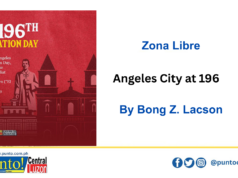PERFECT 9. This would have been my official status and my day post if today were the late 70s, the 80s or even the 90s and social media was already in vogue. I am sure many of my friends would have posted the same, after having completed the nine early morning Masses as their personal panata.
After the first simbang bengi, I was with some of Macabebe’s older folks looking at the native delicacies being sold at the gates of the church patio. We were excited to buy staple items that added a unique feel to the festive mood of the season – puto bumbong, bibingkang galapong, bibingkang nasi, suman bulagta, suman ebus, suman darak mais, and bobotu. Funny how even in food choices, the age gap could be very glaring. While we were overwhelmed by the choices right before our very eyes, the young ones rushed to Jollibee and McDonalds which had early opening hours, while some went to the nearby tapsilogan and paresan stalls.
I was joined by a balikbayan in his late 60s who told me that whenever his vacation fell during the holidays, he wouldn’t miss this whole experience for the world. To him, the Misa Aguinaldo is a cherished Christmas tradition that evokes memories of a simpler time, long before the rise of social media, modern distractions and yes, global warming!
The mention of global warming had me smiling because I remember vividly how the start of the nine dawn Masses also meant pulling out our sambras, ultra thick clothing and sweaters from the family aparador. Back in the days, global warming had not yet dramatically altered the climate. The cold weather during the Christmas season was a defining feature of the Misa Aguinaldo. The cool breeze made the early mornings feel special, but it also required determination and effort to leave the warmth of one’s home.
Today’s younger generation may not believe it but we had our share of Baguio feels right in our hometown. The main plaza all the way to the rice fields in the barrios and the long stretch of Barangay San Gabriel to the caballeriza in Caduang Tete were filled with a thick fog as town folks walked to the church. Looking back, I would like to believe that the challenge of waking up early and braving the cold weather added a sense of admiration and eagerness to the entire experience.
The streets which were dark and quiet from the night before to the dawn the next day, would suddenly come alive with the sound of footsteps as people made their way to the church, often bundled up to face the chill of the early morning. With no alarm clocks, and water heaters installed in our bath rooms, it was difficult for us to rise from bed and walk through the cold. We had to rely on the ringing of the church bell, or the mosikus going around the población area, or our own parents who would not stop from waking us up so we can attend the simbang bengi.
In the absence of modern technology, the simbang bengi was not only a religious event. It was also a communal gathering that brought people together in the spirit of devotion and celebration. And without smart phones and social media accounts, the older generation had their eyes, their minds and their hearts more focused on the moment – on the connection with their faith and their community. There were no selfies, no my day, no reels while the Mass was ongoing.
Let’s face it. Technology is here to stay and it will continue to compete for attention. At the same time, global warming is real and it will continue to alter weather patterns around the world. Despite this, the simbang bengi remains a powerful symbol of Catholic faith and Filipino culture. The conditions and defining features may have changed and are expected to continue evolving; but the spirit of devotion, community, and anticipation that truly defines this tradition continues to endure. As we continue to adapt to the ever-changing world around us, the simbang bengi remains a time for families to gather, for old friends to reconnect, and for the community to celebrate the true meaning of Christmas.





